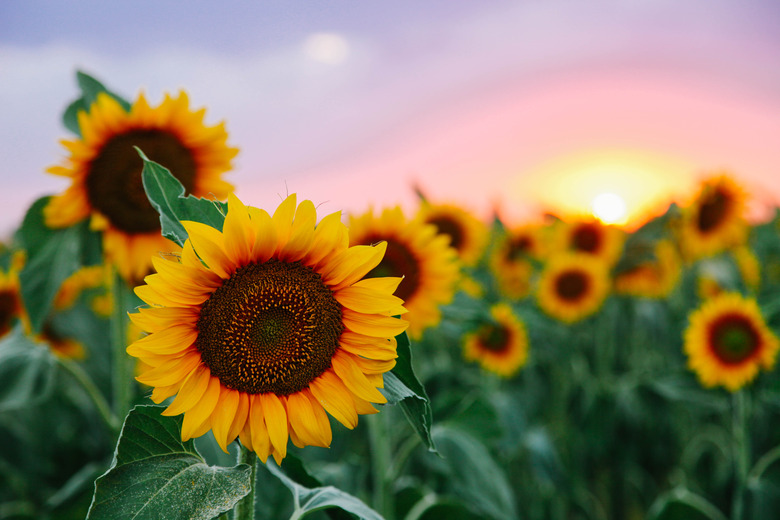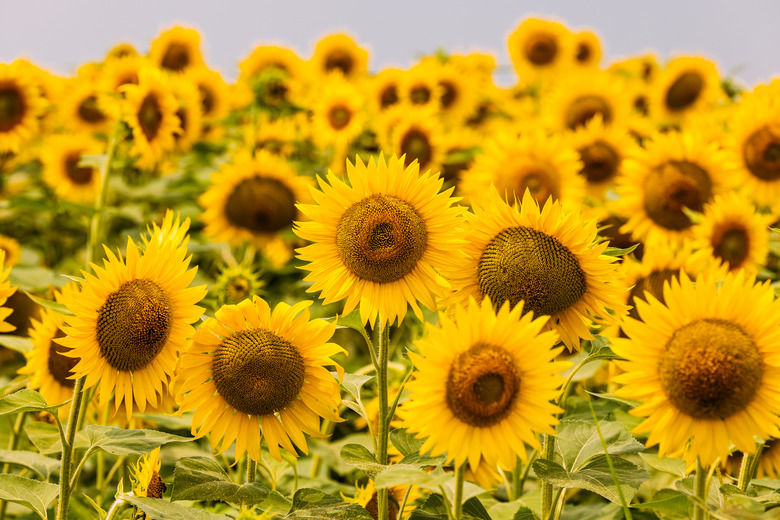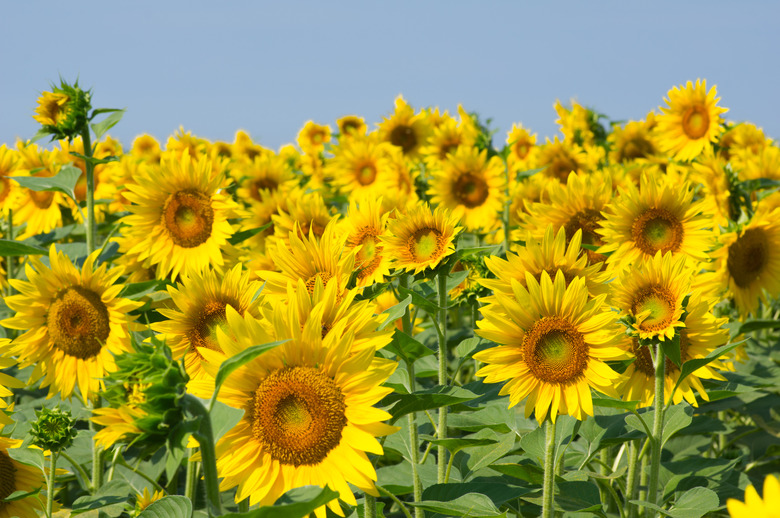How To Grow Sunflowers
We may receive a commission on purchases made from links.
Sunflowers (Helianthus spp.) may be one of the most recognizable flowers in the world. Even the most horticulturally challenged person has little trouble recognizing these plants, some as tall as 10 feet or more, with dinner-plate-sized flowers that contain bright yellow petals surrounding a dark center. While yellow is the most common color, other varieties have maroon, brown, or orange flowers.
Most sunflowers are annuals, although there are perennial sunflower varieties. The plant is native to North America, but it is now grown all over the world. Before the arrival of Europeans, indigenous peoples used the plant as a food source — its seeds are still eaten today — as well as for medicinal purposes and to make dyes.
Sunflowers grow quickly, reaching maturity in a few short months. The plant provides blooms from midsummer to early fall. This low-maintenance plant does require regular watering to become established, but it can tolerate brief spans of drought.
Best Uses for Sunflowers
Best Uses for Sunflowers
Because of their height, traditional sunflowers are best planted to the rear of borders and along property lines. Single plants can be striking, but they are at their best when planted in groups. Some sunflowers are heliotropic, meaning they follow the path of the sun, but once established, they settle into an eastern-facing posture. Keep this in mind when planning a garden because you don't want to be looking at the back of mature plants.
The most popular sunflowers are the tall cultivars, such as 'Mammoth' and 'Paul Bunyon,' but dwarf cultivars, such as 'Teddy Bear,' are also available. These reach 2 to 3 feet in height. They do well when planted in pots, and they are great additions to cutting gardens.
Sunflower seeds attract birds, bees, squirrels, and other wildlife. If you plan on harvesting the seeds for yourself, you will need to beat the backyard critters to them or protect the plants with netting.
Although not as popular, there are also perennial sunflowers such as the Maximilian sunflower (Helianthus maximiliani, USDA hardiness zones 4-9). While annual sunflowers bloom the year they are planted, many perennial sunflowers will not produce blooms until the second year after planting. Many perennials tend to resemble daisies more than the traditional sunflower. In fact, sunflowers are part of the Asteraceae family — the daisy family.
Starting Sunflowers From Seed
Starting Sunflowers From Seed
Sunflowers do best when the seeds are sown directly in the soil. Sow seeds in a trench that is about 1 1/2 to 2 inches deep. For smaller varieties, space seeds 2 to 4 inches apart. Larger plants should be spaced 6 to 8 inches apart. Cover the seeds and water them.
The seeds will germinate in about seven to 10 days, and the plants will flower in two to three months. If seedlings are growing close together, thin them to give individual plants room to grow. Follow the spacing requirements on the seed package; some varieties require 24 inches between plants to reach their full height and seed production. For continuous blooming, plant additional rows about 2 feet apart every two weeks for a month to six weeks. This will ensure blooms throughout the summer and into the fall.
To start seeds indoors, wait to sow them until about one week before the last frost date. Sunflowers grow quickly, and you don't want the plants to be too large for transplanting. Place two seeds in each peat pot or starter tray. Once they germinate, remove the weaker plant.
Harden off the seedlings before planting in the garden. Hardening off involves gradually introducing the plants to the outside elements before planting them. Sunflowers require hardening off to avoid transplant shock. Plant after all danger of frost is over and the seedlings are 3 to 4 inches tall. Plant by placing them in a hole that is as deep as the starter tray.
In What Zone Do Sunflowers Grow Best?
In What Zone Do Sunflowers Grow Best?
Annual sunflowers can grow anywhere from Alaska to northern Mexico. As long as the soil drains well — they don't like waterlogged earth — and they get full sun, the plant should do well in any zone. Perennials have a more limited growing area, but there are varieties that can withstand zone 3 conditions.
Because of their size, strong winds can harm tall varieties of sunflowers. You can protect them by planting them near fences or the walls of a building as long as the plant receives full sun for at least six hours a day. Taller varieties often require staking to keep them from falling over. Tie the stems to bamboo stakes using strips of cloth.
When Should You Plant Sunflowers?
When Should You Plant Sunflowers?
Wait until all danger of frost has passed before sowing seeds directly into the soil or for transplanting starter seedlings. Seeds need soil that is around 50 degrees Fahrenheit. For most of the country, that is in the April to May range. Some warmer regions can plant as early as St. Patrick's Day.
Soil, Sunlight, and Water Recommendations for Sunflowers
Soil, Sunlight, and Water Recommendations for Sunflowers
Sunflowers have tap roots that go deep into the ground. To accommodate them, work the soil in the planting bed to a depth of about 2 feet. Most varieties can grow in any type of soil. They can even tolerate slightly acidic and slightly alkaline soil with a pH of 6 to 7.5. The pH is a measurement of soil balance — how acidic or alkaline it is on a scale from 1 to 14. A measurement of 7 indicates neutral or balanced soil.
The soil itself should be rich in nutrients. When preparing the bed, work in organic matter like compost. The plants usually don't require additional fertilization, but if your soil is lacking, apply a general-purpose slow-release granular fertilizer when planting.
Sunflowers need a full dose of sun every day to thrive. The height of tall varieties offers an advantage in that they can shade other plants that thrive in a little shade. Be careful about planting around sunflowers. There is evidence that sunflower seeds or the hulls of the seeds release a chemical that can limit the growth of other plants. This helps suppress weeds, but the toxin can affect other plants as well.
When first planted and when sprouts start to show, water close to the base of plants 3 inches from the stem. Once established, water once a week during normal conditions. Water deeply to encourage strong roots. Adjust the watering schedule during very dry or very wet periods.
How to Harvest Sunflowers
How to Harvest Sunflowers
Some varieties produce small, dark seeds used for cooking oil and bird feed. The larger varieties produce seeds with striped hulls that make nutritious snacks for people. Birds also like these larger seeds. It's harvest time when the back of the flower head turns brown, the foliage fades to yellow and the seeds look plump and loose.
Here's how to harvest sunflower seeds:
- Remove the sunflower heads and a few inches of stem from the plants.
- Hang them in a dry, well-ventilated space that is rodent-proof.
- When the seeds are dry, remove them from the flower by rubbing two flowers together, or you can run your fingers or a fork through the seeds to dislodge them.
- Be sure to do this over a container that catches the seeds as they fall.
- Spread them out to continue drying and then place them in sealed glass jars for later use.
You can hull and roast the seeds for snacks, or you can use the seeds in bird feeders. You can also save some seeds for planting next spring.
Common Pests and Other Problems for Sunflowers
Common Pests and Other Problems for Sunflowers
When it comes to sunflowers, prevention may be the best defense against the few pests that can harm them. Good garden hygiene, such as cleaning up and removing weeds and other debris from around plants, can help prevent infestations.
Some pests can harm plants, including the sunflower moth. When the moth's eggs hatch, the larvae move into the flower head to feed, killing the flower. In most cases, handpicking the larvae and dropping them into a jar of soapy water eliminates the problem, especially if you are dealing with a small number of plants.
If there is a large infestation involving a number of plants, apply a product containing Bacillus thuringiensis (Bt). The larvae will die when they consume the Bt. Follow the manufacturer's directions for application because rain can weaken the effectiveness of the product.
Cutworms eat the leaves of the plant, making the plants wilt. Manually removing the worms is the best option. You can also prevent damage by using a pesticide formulated for cutworms, such as Bacillus thuringiensis var. kurstaki (BtK). Be sure to read the product label, because all strains of Bt are not formulated for cutworms.
Sunflower beetles feed on the plant's foliage. Removing the adults by hand is the best control strategy. If there are large populations of aphids, remove them with a jet of water from your garden hose or apply horticultural soap.
Common Diseases for Sunflowers
Common Diseases for Sunflowers
Although they are fairly robust plants, sunflowers may succumb to a few fungal diseases, such as downy mildew and powdery mildew. These are similar in that they start off as spots on the leaves or stems and then grow into puffy masses. Downy mildew affects both sides of the leaf, while powdery mildew is usually confined to the top of the leaf.
Most mature sunflowers won't be affected by either downy or powdery mildew, but neither is very attractive. If you catch it early enough, you can apply a fungicide that will protect unaffected leaves and plants. Affected leaves should be removed and destroyed. Don't compost diseased material.
Some fungal pathogens can be spread from other plants and through garden tools. Remove weeds and other debris, including in the fall when preparing the garden for winter. Sanitize tools by wiping the blades with isopropyl alcohol before making each cut.
Verticillium wilt is another fungal disease that affects more than 300 plants, shrubs, and trees. This disease starts in the soil and invades a plant through the root system, eventually killing it. Unfortunately, there's no cure once a plant is infected. The only recourse is to remove the plant entirely.
There are many plants that are immune to verticillium wilt, so use one of those to replant in the area. Some gardeners try to kill the fungus through solarization. Loosen the top 6 to 12 inches of soil and cover it with a plastic tarp. As the sun heats the soil, the tarp holds the heat in place. Solarization takes about three to four weeks to work.


